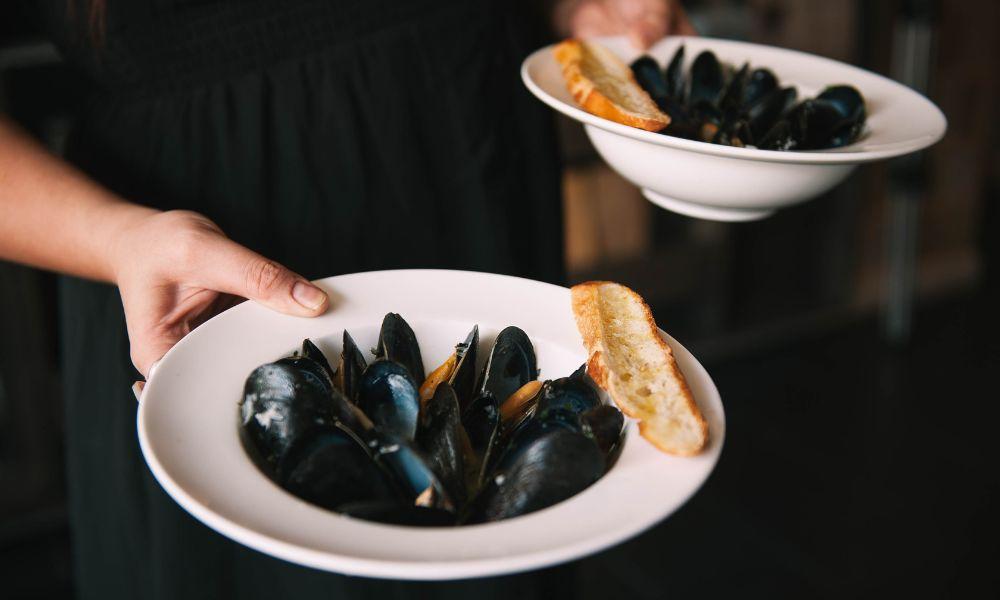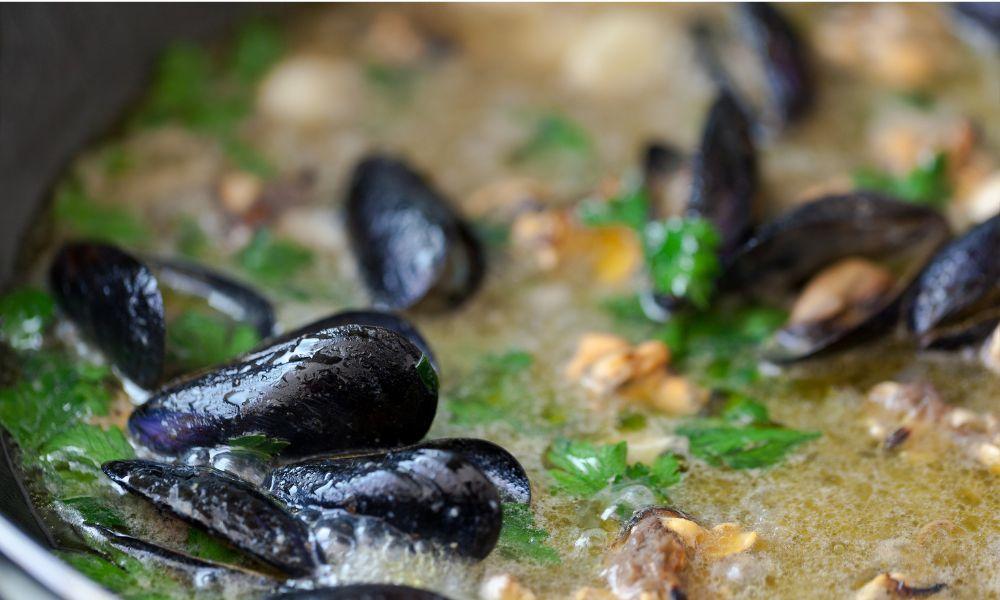Venture on a delicious journey as we explore the world of mussels, a globally loved seafood star. In our culinary spotlight today is the battle of tastes and qualities: PEI mussels vs regular mussels. From the bountiful waters of Prince Edward Island in Canada comes the flavor-rich PEI mussels, while the versatile regular mussels are harvested from various regions across the world.
Throughout this article, we’ll delve into the nitty-gritty of their differentiating factors – from historical origins to taste distinctions. Drawing from professional exposure at Boat Basin Cafe Downtown New York (now closed) and extensive culinary wisdom, I am thrilled to be your guide on this palatable adventure.

Facts from the past: History and Origin
| PEI Mussels | Regular Mussels | |
|---|---|---|
| Origin | Prince Edward Island, Canada | Worldwide (Such as Europe, Americas, Asia) |
| Starting History | Cultivation started in 1970s | Consumed since prehistoric times |
| Intense Nutrition | High in Protein, Iron, Zinc, Selenium, Vitamins C, B12 and Omega-3 fatty acids | High in Protein, Selenium, Zinc, Manganese, Vitamins A, B, C |
| Cooking Methods | Often steamed, works well with cream sauces and Asian flavors | Frequently steamed, perfect for hearty dishes like stews and pasta |
| Taste | Slightly sweet & subtly salty with a tender texture | Slightly stronger, briny flavor with a firmer texture |
| Sustainability | Suspension farming with minimal environmental impact | Often sustainably farmed with various environmental impacts depending on region and methods |
PEI Mussels
PEI mussels owe their existence to the pure waters surrounding Canada’s Prince Edward Island. Mussel farming first took root in PEI in the late 1970s, exploiting the island’s uncontaminated waters to create a breed of mussels known for their superior taste and size.
Regular Mussels
Contrastingly, regular mussels, including the widely consumed Mediterranean mussels (Mytilus galloprovincialis), trace their roots much farther back. Flintstone to Iron Age, mussel shells often surface at ancient cooking hearths, suggesting a culinary preference dating back to prehistoric times. Presently, they are bred and harvested globally, spanning Europe, the Americas, and Asia.
The Nutritional Breakdown

Mussels are celebrated not just for their taste, but also for their stellar nutritional profiles. However, comparing the nutritional value of PEI vs regular mussels requires considering certain variables such as the changing nutrient content in wild mussels due to fluctuating environmental factors.
PEI Mussels
PEI mussels are a rich protein source, housing minerals like iron, zinc, and selenium essential for a balanced diet. Furthermore, they are a great Vitamin C and B12 source. What sets PEI mussels a notch above is their high omega-3 fatty acids content, known for their extensive health benefits.
Regular Mussels
In the opposing corner, regular mussels stand firm, offering an equally imposing nutritional punch. Matching PEI mussels in protein content, they possess vitamins A, B and C, and essential minerals like selenium, zinc, and manganese. Healthy and tasty, what is there not to like?
Just how different do they taste? Does their texture vary? Stay tuned as we evaluate these factors and discuss cooking methods and sustainability standards in the following segment of this culinary voyage!
Cooking Tips and Tricks

Unlock the maximum potential of mussels with these expert-recommended cooking methods:
Best Methods to Cook PEI Mussels
PEI Mussels possess a slightly sweet and subtly salty flavor that doesn’t require much to shine; simplicity is the key here. Their taste gets amplified when steamed with a white wine base, combined with garlic and shallots, truly bringing out their oceanic flavor.
In another method, a creamy wine-based sauce infuses into the PEI mussels, making them a delightful pairing with crusty bread for a gourmet touch to your meal.
Considering the Asian flavor route, try cooking PEI mussels in a lemongrass-infused coconut milk broth. Add a dash of ginger and chili for an exotic twist, transforming them into a sublime dish that bursts with flavors.
You also can buy cooked PEI Mussels here.
Cooking Regular Mussels to Perfection
Much like their PEI counterparts, regular mussels also revel under the classic white wine and garlic style of cooking. However, their robust flavor and firm texture make them the perfect contender for hearty preparations.
Mussel stews are a traditional favorite, where regular mussels are cooked with Italian sausage, rich tomato sauce, and a hint of saffron for that extra warmth.
For a comforting, single-pan dish, toss regular mussels with pasta, garlic, and olive oil. Finish with a squirt of lemon zest and freshly chopped parsley for a Mediterranean masterpiece at home.
👩🍳Remember: Avoid overcooking mussels, as they can turn rubbery and lose their taste. A good sign of perfectly cooked mussels is when their shells fully open. Discard any that don’t open after cooking, since this generally indicates a dead or unhealthy mussel.
😀You may also like: Green Mussels vs Black Mussels: The Differences Will Surprise You!
FAQs
What is the primary difference between PEI Mussels and Regular Mussels?
PEI Mussels come from the pristine waters surrounding Canada’s Prince Edward Island and are known for their slightly sweet, subtly salty flavor and tender texture. Regular Mussels hail from various locations worldwide and tend to have a stronger, briny flavor with a firmer texture.
Which type of mussels is more nutritious?
Both PEI and regular mussels have high nutritional value. However, PEI Mussels are noteworthy for their high omega-3 fatty acid content. Regular mussels counter with high levels of selenium, zinc, and manganese.
What are some recommended ways to cook PEI and Regular Mussels?
PEI mussels often pair well with cream-based sauces and Asian flavors, while regular mussels stand up well to hearty preparations like stews and pasta dishes. Both can also be simply steamed in white wine with garlic and shallots.
Are both PEI and Regular Mussels sustainable seafood choices?
Yes, both are sustainable seafood options. PEI mussels farms use suspension farming practices, which have a minimal impact on the sea bed. Regular mussels are also farmed sustainably using a variety of techniques based on the region and farming practices.
Which mussel type should I choose for my dish?
The choice depends on your personal flavor preference and the type of dish you’re preparing. If you prefer a slightly sweet and tender mussel, choose PEI mussels. If you want a stronger, briny flavor and firmer texture, choose regular mussels.






